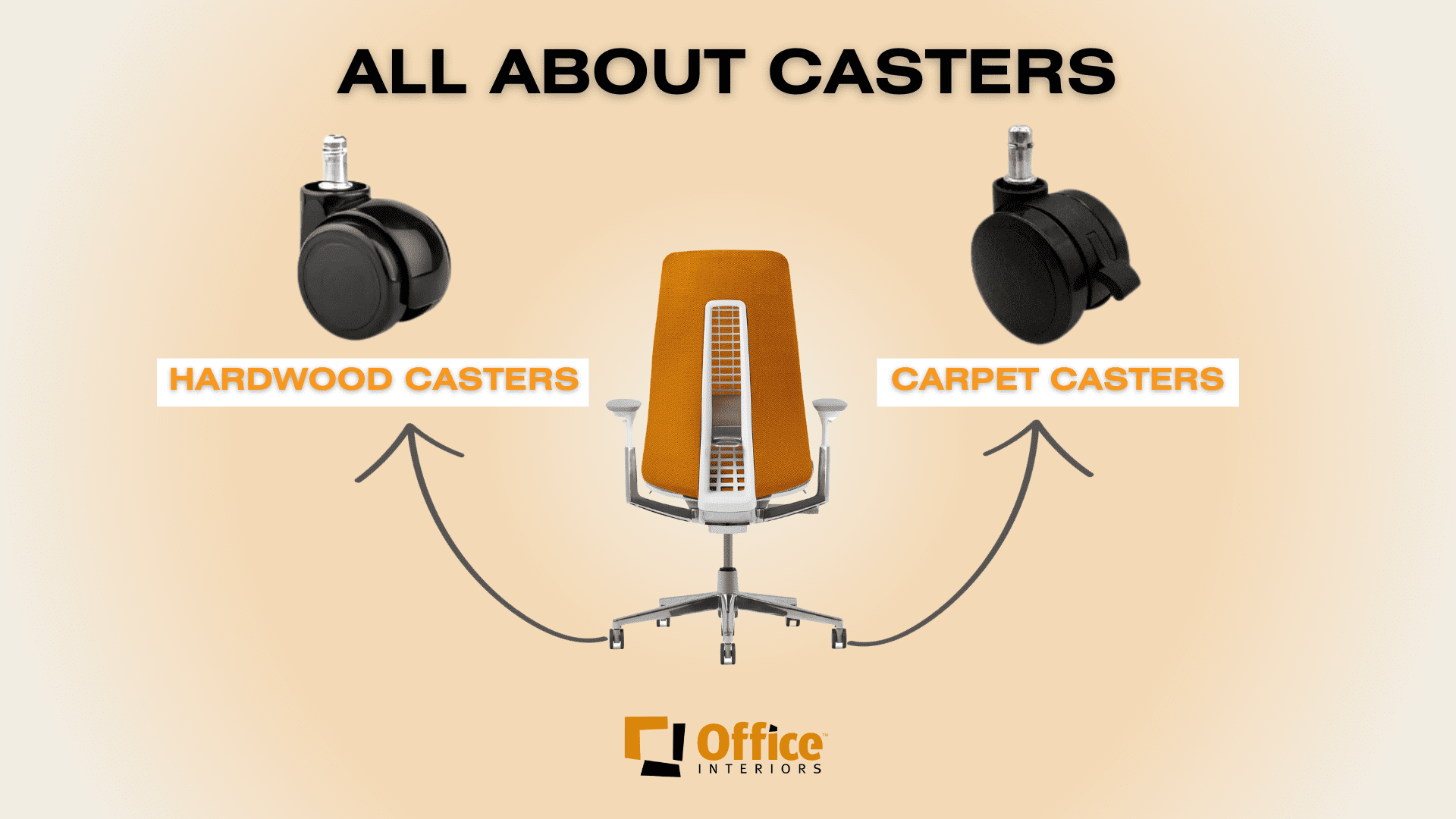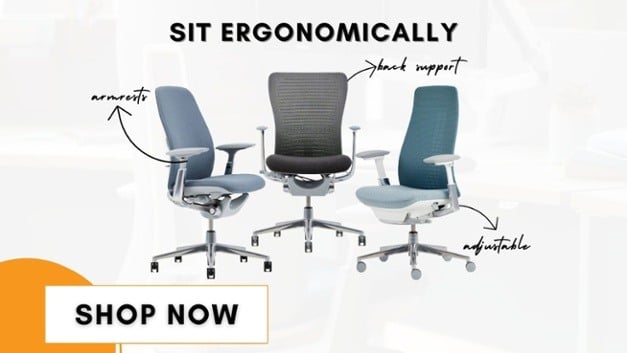
Picture this:
You are in the market for a new task chair that will make your workdays more comfortable. After looking around, you finally found one that meets all your requirements. You have carefully examined all its ergonomic features, which promise both comfort and productivity. This choice leaves you feeling very satisfied with your selection.
However, you have one seemingly minor question: Does this chair come with glides or casters? You are told it comes with casters, leading to your follow-up questions. “Will the casters work smoothly on my office floor? What type of caster is it? Specifically, are they carpet casters or hardwood floor casters and how do I tell the difference between both types of casters?”
TL;DR (Summary)
- Casters are wheels attached to furniture bases to allow movement. Types include swivel, rigid, locking, and brake casters.
- Carpet casters are made of hard plastic, have larger wheels, and roll smoothly on carpet without sinking or damaging fibres.
- Hardwood casters use softer, non-marking materials like rubber or neoprene with medium wheels to protect floors.
- Using the wrong caster can cause floor damage, ergonomic issues, noise, reduced durability, and safety hazards.
- Always match your caster type to your flooring to extend chair life and protect your workspace.
This is where we come in to help you understand your casters. In this article, we will explore the world of casters, the distinctions between carpet and hardwood casters and how to choose the right caster wheels to protect your floors while enhancing your sitting experience.
What are Casters?
Before we delve into the distinctions between carpet casters and hardwood casters, let’s first explore the versatile world of casters themselves. Casters are wheels attached to the furniture base, making moving and repositioning them easy. You will commonly find casters on chairs, tables, carts, and other pieces of furniture. They are designed with various features to cater to diverse needs and applications, making them a valuable component in furniture and mobility.
Types of Casters
Casters come in a range of types to suit different requirements:
- Swivel Casters: These casters offer a full 360-degree rotation, allowing for versatile movement in multiple directions. They are ideal for tasks that require swift changes in directions, making them a popular choice for office chairs and mobile carts.
- Rigid Casters: Rigid casters are great for straight-line movement. They move only in one direction, which can be beneficial for transporting heavy equipment or large furniture items in a controlled manner.
- Locking Casters: Some casters incorporate a locking mechanism, which, when engaged, prevents movement in situations where stability and safety are essential. This feature prevents unintended movement, such as when you want your chair to remain stationary.
- Brake Casters: Brake casters have a brake mechanism that directly contacts the wheel surface to stop it from rolling. They typically have a foot-operated pedal that you press to engage the brake and release to disengage the brake. This feature provides a more immediate and secure stop.
Now that you know the different caster types that your task chair can come with, let’s take a closer look at carpet and hardwood casters, understanding their differences and how to tell them apart.
Carpet Casters
Carpet casters, as the name implies, are designed to be used on carpeted surfaces. This caster is standard and often the default caster on a new chair.
Features of Carpet Casters
- Plastic Construction: Manufacturers typically use plastic to make carpet casters, which are durable and resistant to wear and tear. The hard threading on these casters firmly grips the carpet, preventing slippage and enabling it to run smoothly over the carpet.
- Large Wheel Size: A prominent design element of carpet casters is their relatively large wheel size. They serve a dual purpose. Firstly, it helps distribute the weight of the chair or furniture more evenly, which is essential for preventing any undue pressure on the carpet fibres. This safeguards the carpet from being damaged by the weight. Secondly, the larger wheels reduce the risk of the casters getting stuck in the carpet, minimizing wear and tear and providing smoother, more consistent mobility.
Hardwood Casters
On the other hand, hardwood casters are designed to function optimally on hard floors such as hardwood, laminate, or tiles.
Features of Hardwood Casters
- Soft Threads: Hardwood casters have softer threads designed to grip hard surfaces effectively. This grip ensures that the casters do not slide or skid on smooth floors.
- Non-Marking Materials: Hardwood casters are often constructed with non-marking materials to safeguard your hardwood floor from unsightly marks or streaks. These materials, such as rubber, neoprene, nylon, or polypropylene, prevent any damage to the floor’s surface. You should be able to create a slight indentation on the outer edge of this caster with your fingernail.
- Medium-Sized Wheels: Unlike the larger wheels on carpet casters, hardwood casters generally feature smaller to medium-sized wheels. These dimensions are well suited for smooth, hard surfaces.
Effects Of Using Incorrect Casters
Choosing the wrong type of casters can lead to undesirable consequences that affect both safety and functionality.
- Safety Hazards: Choosing inappropriate casters can create unsafe conditions. For instance, using a caster not designed for heavy load can lead to instability, tipping, and even accidents. Using the proper caster selection is essential to prevent mishaps, whether in a workplace or a home office.
- Ergonomic Issues: Casters play a critical role in office ergonomics. Utilizing the wrong casters for your chair can negatively impact your posture and comfort. For example, using carpet casters on hardwood floors can make it difficult to move the chair, potentially causing strain and discomfort as you try to move around.
- Flooring Damage: The wrong casters can damage your flooring. Using hardwood floor casters on soft surfaces like carpets can cause premature wear and tear on the casters and the flooring. Conversely, carpet casters on hard floors can result in scratches, scuffs, or dents on the floor’s surface, leading to costly repairs or replacement.
- Noise Disturbance: Using casters designed for rough surfaces on smooth floors can produce excessive noise due to vibration and rattling against the hard surface. This noise can be disruptive in a quiet office setting and affect concentration and productivity.
- Reduced Durability: Incorrect casters may not be able to withstand the demands placed on them, leading to accelerated wear and tear. This results in the need for frequent replacement, causing unnecessary inconvenience and expenses.
Frequently Asked Questions
What are carpet casters best for?
They are ideal for carpeted surfaces. The hard plastic design and large wheels prevent sinking into fibres and allow smooth rolling.
What are hardwood casters best for?
They are designed for hard surfaces like hardwood, laminate, and tile. They use soft, non-marking materials that protect floors from scratches and streaks.
How can I distinguish between carpet and hardwood casters?
Carpet casters are typically hard plastic with large wheels. Hardwood casters have softer treads that you can press with your fingernail and are often smaller or medium-sized.
What happens if I use the wrong caster?
You risk damaging floors, creating safety hazards, increasing noise, and reducing chair comfort and durability.
Do casters affect ergonomics?
Yes. The right casters improve mobility and reduce strain. The wrong casters can make movement harder and affect posture.
Your Perfect Chair Deserves Perfect Casters
Are you team carpet casters or hardwood casters? You likely have a clear idea of which casters will pair well with your new ergonomic task chair to enhance your productivity, improve your seating experience, and ultimately protect your flooring. If you have any questions or need assistance, contact us. We would be happy to help.
Fola is the Marketing Coordinator at Office Interiors. She creates content and drives digital marketing initiatives that help customers navigate workspace-related questions with confidence.
Subscribe to Our Blog
Contact Us
If you’re ready to start improving productivity, streamlining processes, and love the way you work through optimized workspaces and office technology, contact us today. Our team of experts is here to help!
Topics:


